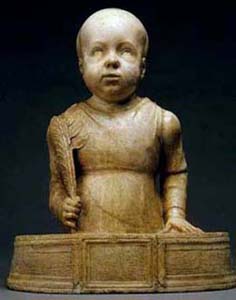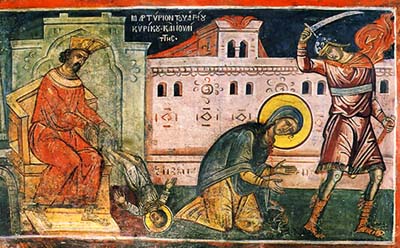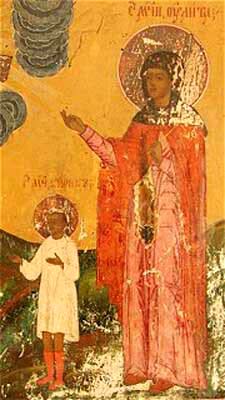 |
Catholic Virtues
St. Cyricus and His Mother St. Julitta
Judy Mead
Recently, my friend and I visited the medieval section of the J. Paul Getty Museum in downtown Los Angeles. If you are in the area, I would highly recommend a visit to that mammoth structure, made of remarkable travertine marble, that sits on a small mountain over the city. On a clear day you can view the Pacific Ocean on one side and the entire Los Angeles basin on the other.

St. Cyricus
|
As we exited one room of paintings, the life-size bust of a young child at the left of the doorway caught my eye. With an expression of great seriousness and confidence, a young child raises his eyes to Heaven. Except for some small sign of tension at the shoulder of his left arm, slightly bent, his figure is completely calm. His bearing is composed, his attitude serene. Still, one senses a spirit of expectance, that of a child who knows he has done well and now stands respectfully before his father, awaiting the reward he is sure to receive.
Moving my gaze from that sweet riveting face, I saw a palm and a laurel branch in his right hand, the signs of martyrdom and victory over death. They help to identify the boy as the infant Saint Cyricus (also known as Cyr, Cyriacus, Quiriac or Quiricus). The placard at the side of the sculpture states that in the late 3rd century, this Roman toddler was martyred at the age of three, along with his mother Saint Julitta, a Christian who refused to pray to false idols. Their feast is celebrated on June 16.
The martyrdoms of St. Cyricus and St. Julitta
The mother and child were martyred during the last particularly fierce persecutions of Catholics under the Emperor Diocletian (284-305). The Golden Legend relates that Cyricus was the son of Julitta, a noble lady of Icona. In order to escape persecution, she took refuge at Tarsus in Cilicia with her child, who was then three years old. She was recognized as a Catholic and reported to the authorities, and brought before the tribunal of the prefect Alexander. Because her two servants took flight, she had to bring her small son with her.
When Julitta refused to pray to the idols, the prefect Alexander took the child from her arms and ordered her to be whipped with raw thongs. At the sight of his mother’s tortures, Cyricus began to cry out and shed tears. Alexander, who was holding the child in his lap, tried to quiet him with caresses and kind words. But the small child repulsed these blandishments with honor and scratched Alexander’s face with his nails, crying out, “I am a Christian!”

The prefect Alexander hurls the boy down, smashing his head on the steps; soon after the mother is beheaded
|
In astonishment, the prefect asked him who had taught him to speak. And the child answered, “Thy lack of wit is a wonder to me, that, seeing my age, you need ask who instructed me in the knowledge of the true God!” And he repeated the words, “I am a Christian!”
Enraged, Alexander raised the child and hurled him down, dashing his head on the steps of the tribunal. Julitta, filled with joy, gave thanks to God that her son had gone before her into the heavenly realm. She herself was then flayed, plunged in boiling pitch, and at last beheaded.
To prevent them from being buried by the Catholics, the prefect ordered their bodies to be cut in pieces and scattered in different places. But an Angel collected the members, the Golden Legend tells us, and they were buried by the Catholics under the cover of the night. Later, when peace was restored to the Church, an aged serving woman made known the resting place of the two bodies.
Devotion to the mother-son martyrs grew, especially in France, after Bishop Saint Amator of Auxerre brought some relics to the monastery of Saint Armand in the Tournai in the 4th century. Also, Charlemagne had a devotion to him and restored a cathedral dedicated to Saint Cyr. Saint Cyricus is the Saint Cyr found in several French place names.
A lost notion of heroism

Mother and son are models of heroism in proclaiming the Catholic Faith
|
In this moving story, I was impressed by the lack of sentimentality of the early Christians. Julitta did not weep at the death of her son, but, instead, celebrated the fact that he had earned the crown of martyrdom. This is the heroic position of a true Catholic, who considers the life of the soul above the life of the body.
Certainly, this history counters the excessively sentimental view of parents and children that Hollywood always presents. In so many films one sees today, the parents consider the lives of their children the supreme value. There would be nothing worse than for a child to die. I imagine some persons today would cringe at this beautiful story of St. Cyricus or complain that Julitta is a cold-hearted mother. The modern age has lost the notion of the value of our Faith, as well as of heroism and martyrdom.
I think St. Cyricus and his valiant mother, St. Julitta, are excellent models for our age. Here is a toddler barely at the age of speaking, certainly not at the age of reason, whom the Holy Ghost inspires to declare, “I am a Christian.” His mother had refused to burn incense before the false gods, knowing that death would be the sentence. She might have been wondering, “What will happen to my boy? Will he grow up in the pagan court and reject the true Faith? I had better concede for his sake.” She did not concede, and she was given the consolation to see that God provided for her son in a better way than she could have: He gave the young boy the crown of martyrdom before her own, insuring that they would not be separated in death.
Today, we have priests and Prelates offering incense, so to speak, to false gods, praying with heretics, compromising with all kind of errors to maintain a false peace. This is a strange new path - never approved by the Church until Vatican II - not the path of the early martyrs. Let us pray to St. Cyricus and St. Julitta for the courage to be intransigent in proclaiming the Catholic Faith, even if it means facing criticism, losing friends, being alone. This is a sure way to advance on the narrow path to Heaven.

Posted on June 14, 2008

Related Topics of Interest
 St. Philippine Duchesne: Failures Became Her Success St. Philippine Duchesne: Failures Became Her Success
 Ven. Antonio Margil: Apostle of New Spain and Texas Ven. Antonio Margil: Apostle of New Spain and Texas
 St. Therese of the Child Jesus: Master of her Temperament St. Therese of the Child Jesus: Master of her Temperament
 The Lesson of Lourdes on Suffering The Lesson of Lourdes on Suffering
 Perseverance in Prayer Perseverance in Prayer

|
Catholic Virtues | Religious | Home | Books | Tapes | Search | Contact Us | Donate

© 2002- Tradition in Action, Inc. All Rights Reserved
|
 |
|